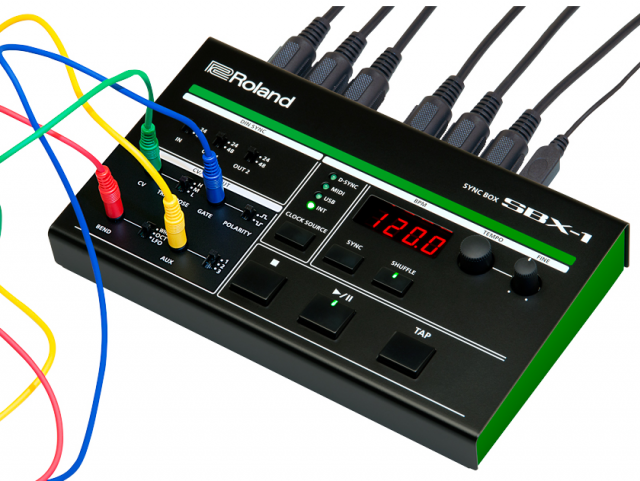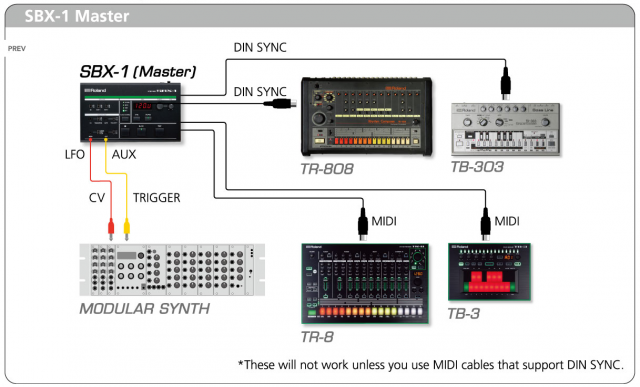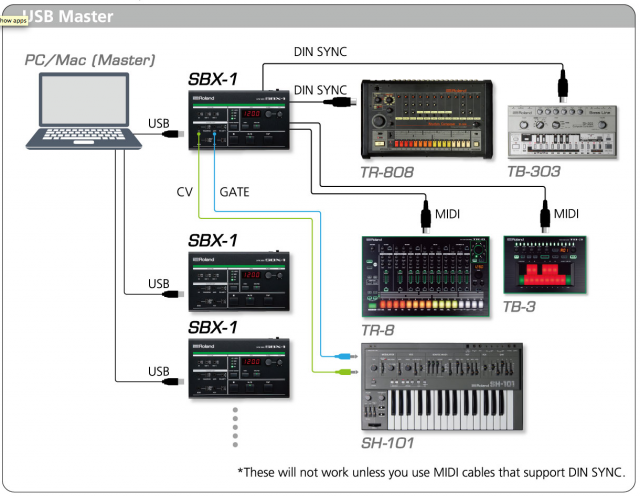
Roland has officially introduced the SBX-1 Sync Box, a utility module that’s the lingua franca of electronic music gear – letting all your gear work together, whether its DIN, MIDI or control voltage gear, vintage or new, and hardware or software.
The Roland SBX-1 Sync Box opens up new ways of working with your gear.
SBX-1 is designed specifically to make it easy for computers and electronic instruments communicate and synchronize with each other. It supports a vast array of both analog and digital devices through DIN SYNC, MIDI and USB, and any of these can be the master clock source.
You can also use the SBX-1 itself as the master sync and control your external devices using its internal clock. It even lets you bring swing to devices that don’t have it built in, like the TR-808.

Roland’s examples demonstrate how the SBX-1 can be used to keep all types of gear synchronized:

More patching examples are available at the Roland site.
Features:
- Simultaneous conversion between MIDI, DIN SYNC, and USB/MIDI
- Control external devices with SBX-1 as the master sync source
- Shuffle adds swing to patterns generated on devices without swing like TR-808 and TB-303
- CV/GATE jacks introduce enormous creative possibilities
- SYNC button corrects timing errors with a single press
- Output up to three channels of triggers or LFOs with different characteristics
- DIN SYNC supports both Sync24 and Sync48 compatible with a variety of rhythm machines
- Works with the TR-8 through optimized AUX jack
- Runs on USB bus power or with AC adapter
Specifications:
Switch
- [DIN SYNC IN] Switch (24, 48)
- [DIN SYNC OUT1] Switch (24, 48)
- [DIN SYNC OUT2] Switch (24, 48)
- [TRANSPOSE] Switch (H, M, L)
- [POLARITY] Switch (+, -)
- [BEND] Switch (WHOLE, OCT, LFO)
- [AUX] Switch (1, 2, 3)
- [POWER] Switch
Buttons
- [CLOCK SOURCE] button (D-SYNC, MIDI, USB, INT)
- [SYNC] button
- [SHUFFLE] button
- [STOP] button
- [PLAY/PAUSE] button
- [TAP] button
Knobs
- [TEMPO] knob
- [FINE] knob
- Indicators
- [D-SYNC] indicator
- [MIDI] indicator
- [USB] indicator
- [INT] indicator
Display
- 7 segments, 4 characters (LED)
Connectors
- DIN SYNC (IN, OUT1, OUT2) connectors
- MIDI (IN, OUT1, OUT2) connectors
- USB COMPUTER port: USB type B
- DC IN jack
- CV jack: Miniature phone type
- GATE jack: Miniature phone type
- BEND jack: Miniature phone type
- AUX jack: Miniature phone type
Power Supply
- AC adaptor or supplied from the computer via USB
Current Draw
- 150 mA (When using an AC adaptor)
- 200 mA (When using USB bus power)
Accessories
- Owner’s manual
- Leaflet “USING THE UNIT SAFELY”
- AC adaptor
Official pricing and availability information for the Roland SBX-1 are to be announced. For more info, see the Roland site.

The use cases on the website don’t seem to show that you can sync the computer along with hardware to this to this thing. I’m looking for something to replace the terrible Ableton MIDI clock and no one seems to have the SyngGen II Pro in stock.
Can USB be a slave or can it only be the master?
Look at the second picture down on this page, PC/Mac is master!
i am hoping to see wording that says flat out that it can deliver a rock solid sync to your midi gear from the usb plugged into the computer
if it is just a standard usb to midi, i am concerned that jitter will still be an issue
The problem there is on the computer side rather than the device. USB MIDI is crap because it isn’t given realtime priority at the driver level like audio. I don’t think Roland can do anything about that without boxing themselves into a hell of proprietary driver incompatibility..
The SBX-1 is currently £185 from a few outlets (others sticking at £309).
At £185 it represents good value. It is solid and easy to use and does what it says it does. Kenton do a midi to din-sync unit for £71.99 but it gives less functionality and only receives and sends clock midi/din whereas the SBX-1 can be the master clock or it can receive from a number of sources. Also, sends CV/Gate so could be very handy for a Eurorack setup.
At >£300 it was a bit pricey but grab at £185 while still at this lower price!
No battery power. No deal.
9v volt battery would give 2hours of usage
6x AA batteries= 6hrs
this is designed to work with computers, computers have usb, why add extra weight?
my calculations could be off, but my point is still valid. at least they have the option of external psu.
they have, any usb charger will do
I can’t think of anything better than a radio shack remote control car that runs on battery power. This piece of equipment isn’t a cell phone. It’s a piece of professional music hardware.
I don’t know about your statement, or if you live under a rock, but I can think of a few pieces of professional music hardware that run on battery power.
Korg makes some relatively impressive Analog gear that is Battery powered.
Also, isn’t the Roland SH-101 battery powered also?
*shrug
just use an external usb powerpack, way better then a built in battery or to let them choose your mAH
but why would you need a battery if you use so many din/midi or gate synched devices that you need this device at all?
It won’t be in my studio at that price, I’ll build my own!
yeah me too 🙂
Where’s the price? Feeling blind here
How??? Do you have any links to building one???
The price hasn’t been released yet, considering how cheap the rest of the Aira line has been it won’t break the bank and will be super handy and reliable knowing Roland.
Now everything I own will be synced! …except my casiotone….
Whoah! $599 in Australia £399 in uk… Totally utterly ridiculous!?!
Roland “suggested prices” are online at their site.
Iconnecivityt and beat step arturia already connect everything I have for around $150AU why would I pay another $600 just to make my TR-606 play nice?!
Forget it!!
Breaking News !!!
Was passiert !?
bRoland can create and sell usefull devices ?
Great News !
i hope it is rock solid with a computer as master, the price is high but not so much when you compare to similar offerings by innerclock systems and acme4. usb power is handy, batteries were mentioned as a deal breaker but there are plenty of small cheap battery power bricks that could supply ample power over usb so for me that is a non issue. i am glad it has two din sync outs, the lfos are welcome too, it would be neat if they added a stop start for din much like the mungosync in a future update. i am hoping the price falls a bit, and that it forces the competition to drop their super high prices.
Unfortunately Roland doesn’t give us information on the tightess or jitter of the internal and USB slave sync. That’s why I’m glad with my Innerclock Systems Synclock 🙂
From testing about a dozen USB-interfaces (from budget to professional, including the built-in USB-interface of the TR-8) using both Windows 7 32-bit and Windows 8 64-bit my conclusion is: the timing of the Windows MIDI-drivers implementation is fundamentally flawed. I fear clock tracking won’t get anything better than dozens of samples jitter using USB interfaces, until proven otherwise.
Some hardware/driver combinations perform better than others regarding MIDI clock, but jitter is always ruining the party. I like to run MIDI/DIN-synced hardware alongside hi-spead breakcore beats from my computer, and this combination is extremely revealing for clock jitter. My Innerclock wins the battle for tightness handsdown, and I can only hope Roland will get near its performance.
I’m interested to see how this performs also. The only thing coming out of a computer with anywhere near accurate timing is audio, hence why Innerclock uses audio to communicate between the DAW and the breakout box. I thought Roland might go down this route also but it doesn’t look like they have.
I’m interested to see how accurate this is as the engineers must have encountered the same problems as the rest of us when they were developing this. So either their engineers have figured out a way to do this or this is going to be useless for syncing DAWs.
Really anything is going to be tighter than MIDI on Windows, and Microsoft is to blame for that.
Part of that is inevitable, because modern general-purpose computers are doing multi-tasking that dedicated hardware doesn’t have to do. But MIDI on Windows still sucks compared to on the Mac.
By the looks of it, this doesn’t work anything like the innerclock sync gen. Not even in the same ballpark. The sync gen converts audio into clock ultimately bypassing the computers wonky clocking system altogether and creating its own. This is simply a midi-splitter/midi-cv convertor. I wouldn’t get my hopes up for this being any better than any other solution already on the market. I will eat an SBX-1 if the SBX-1 can eliminate clock and jitter
Next an analog poly from Roland?
So the PC can only be a Master?
ie. the MIDI ports are ‘out’ only?
No DCB. Even Roland has no love for this thing.
This will be really useful to me if the CV can be scaled to work with my MS-20!
Now if they come up with a version that has about eight of everything (i.e. connecting multiple analog devices and digital devices in a big gang bang) they would have something. A lot of people have more than one analog in use during a session. I don’t see the point in having to buy multiple of these units if one could be made to handle multiple devices.
my money would still be on innerclock sync gen ii…
but would be curious see how tight its sync is…
Any chance of triggering the juno 60 ‘s arp clock with this thing? greets
Do we have any info if the CV and gate outputs will support other older synths with Hz/V pitch scaling and other trigger types? Like the old Yamaha and Korg synths?
The RH301 by KOMA Elektronik does all of this and additionally gives you a synced ADSR, LFO, opportunities to sync to a analog clock signal and oh yeah: it costs less. Sorry, but I do not get the hype.
I’m not sure that box has USB capability does it?
cheapest sync around 😉 <3
http://vimeo.com/22931625
and rock solid!
That KOMA box is 441 euros… so not much cheaper…
What about the E-RM MIDICLOCK ?
So I’m trying to decide and from what I can find neither the KOMA box or the E-RM MidiClock have USB so that I can sync up Ableton or a DAW.
I hope they come through with a clean USB sync.
(!)
According to the Innerclock ‘Litmus Test’ page, the SBX-1 clock is generated with zero jitter when using USB. (!)
What the test doesn’t say is which program the clock was coming from, whether it was coming from a mac or pc or whether multiple tests were carried out at different tempos.
Apparently you can install the SBX-1 on a mac without a driver, but there is a specific driver available (that has a bit of a convoluted install procedure). I’m wondering if installing the specific driver for the device helps to deliver the jitter free results below? According to the manual, there is a ‘standard’ AND ‘advanced’ USB setting on the SBX itself…
I also have further questions: Can the ‘shuffle’ function be utilised when the clock is generated from USB, and how have Roland managed to create a jitter free device over USB?
Is the jitter free clock via USB because of a phase locked loop in the SBX?
ROLAND SBX-1 TEST RESULTS
Source: USB
> MIDI Clock Out – Max. Jitter between MIDI Clocks: Zero samples (0.00ms)
Average Latency: 10 samples (0.21ms)
> Din-Sync Out – Max. Jitter between Din-Sync Clocks: Zero samples (0.00ms)
Average Latency: 10 samples (0.21ms)